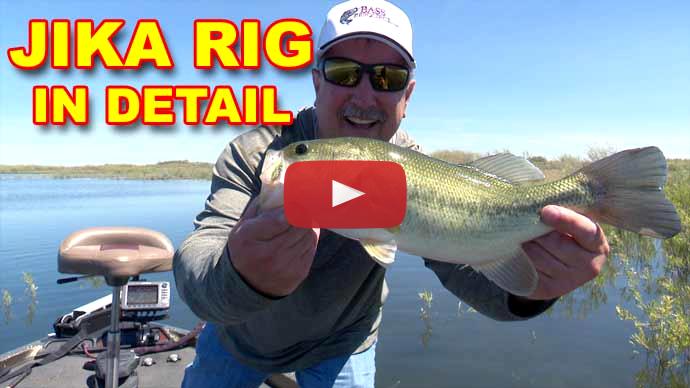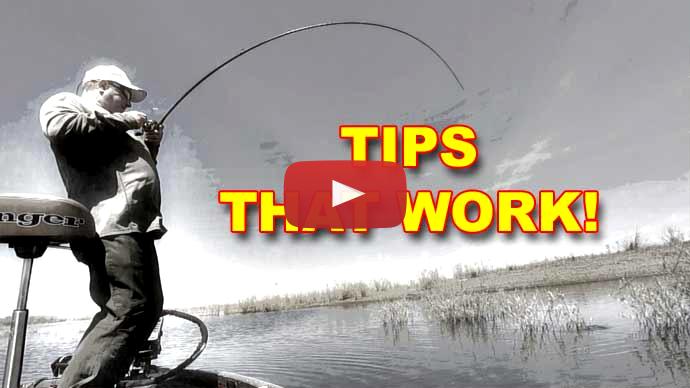There we go! Nice. All right. Come here you. All right. Nice. There you go. Not bad, they're fun. They're, real fun. Good fish. Tokyo rig.
Hey, folks. Glenn May here with BassResource.com, and today I wanna talk about the Tokyo rig for bass fishing. Now, the Tokyo rig, as the name might imply, actually came from Japan, where the lakes are really under a heck of a lot of pressure and the bass are heavily pressured. So, the Japanese are always coming up with inventive ways to find just that little thing, those little nuances that's gonna get those bass to bite under those conditions. Hence, came the Tokyo rig. That's how that was created.
So, a Tokyo rig really hasn't taken a huge popularity here in the United States quite yet or in Canada, but it's catching on, and it's catching on quick.
So, just what is a Tokyo rig? Well, this is what it looks like, guys. Look at that. Can you see that? It's got this wire hanging from a hook, and there's also this. You got a little... You see that? It's a little swivel, a weird-looking contraption. But that's what it's about.
So, how does this all work? Well, let's start first of all. You got the hook that swings freely from this rig, and that enables the bait to move about real naturally just in a way that you can't do with a traditional Texas rig or a jig. It's not attached to anything, so that bait just can flutter and move about naturally. With the swivel that's on it, it enables it to just... It can spin and move around without giving any line twists. So, it really does act real natural in the water.
This wire that's on here, that is where you put your weights. And here's the beauty of it. So, what you do is you just take a bullet sinker and put it on there. Here, I've got one rigged, and then you just bend the bottom of the wire. So, here's what it looks like when it's rigged. You can see here's the bullet sinker right here. And I just bend the wire underneath, and there you go. It's set up.
So, a couple of things you can see here. This is also rigged weedless with this hook. So, now you've got the weedless bait with any weight that you want. You can put any size weight on this at all, which is nice. It's really easy to swap out. Just bend the wire out and put another weight on there and you're good to go. So, unlike a Texas rig where you got to take everything apart and re-rig everything, it's really easy to re-rig with a Tokyo rig.
But what makes all this unique? Well, you get this unique action of the bait and you can get it just off up the bottom and let it flutter horizontally in place, which you can't do with a Texas rig or a jig. And it gives that bait just a little bit different look and feel. The other thing about it is when you're pitching and flipping and throwing it, this weight just hangs straight down. So, it pulls it straight down. So, unlike a Texas rig or a jig where your line is tied to the weight instead of up here like it is with the Tokyo rig, those baits will tend to pendulum toward you as they fall in the water, but this will fall straight down. So, it makes it really easy for targeting and pinpoint accurate casts. So, that is really key, especially if the bass are real finicky and you wanna get that lure right up against the base of that stump or rock or something. It's a lot easier to get there with this bait.
There we go. He is a jumper. Come here, buddy. There we go. That's a nice fish right there. Yeah. The Tokyo rig. These fish are a little reluctant to bite today, but Tokyo rig comes through.
So, let's talk about four main ways to fish the Tokyo rig. It's still new and more and more people are using it. So, there's more than four ways to fish it, but I'm gonna talk about four ways that I fish it. And you can leave some comments down the bottom of this video. Tell me how you're fishing it, I bet you found some inventive ways to use it too.
But let's talk about the four ways I fish it. So, the first one is flipping and pitching. This is what I do the most of, for a couple of reasons. First of all, that weight in the front, it enables that bait to get right down through cover. It just is easy. It doesn't get hung up or anything. It doesn't have that line where the line would drape and pull it back up or miss your target. It slithers right down. And you'd be surprised how easily it comes back out of that cover without getting hung up.
The beauty of it though is that you can give it a drop shot-like look in that cover, something that bass normally don't see. Typically, when you've got a bait with a Texas rig with a weight in the front, it comes nose down and lands on the water like this, and then flops down and falls over. But with this, the Tokyo rig, it falls down but then you've got it by the line here and it sits horizontal. Then it may settle down on the bottom a little bit, but you just pick it back up just a few inches and now it's horizontal in the water. It'll lift up in horizontal. And you can just drag it on the bottom with just the weight hitting and that bait comes along like this, a little bit off the bottom. You can't get that with a jig or with a Texas rig. So, it's a different look that the fish aren't used to seeing. And again, going back to Japan and the heavily pressured waters, that subtle difference is sometimes all it takes to get fish to bite. So, it can mean the difference between catching fish and not. So, it's an important distinction.
Another way to fish it is sight fishing. Not necessarily bed fishing, although it's great bed fishing, but the same action applies whether you're sight fishing or not. If you just see bass cruising, you throw it out there, and again, you just lift up a little bit on it and you get the bait to hover just a bit off the bottom, and then you can relax and let it sit back down and lift it back up, let it hover and quiver and shake a little bit, let it drop back down. It's unlike anything the bass are used to seeing. So, again, they're more apt to biting. So, excellent way to sight fish.
Here we go. All right. There we go. Nice. Healthy fish on a jika rig. Oh, no. Sorry, that's a Tokyo rig. On a Tokyo rig. Thank you much. Good guy. Good fish. Let him go. There you go, buddy. Go right back to your bed. There he goes. Yep. That's awesome. Right smack straight back to his bed. I love it. Tokyo rig, guys. It works.
A third way to fish it is deep. This is kind of an interesting deal here. A lot of times when guys are fishing deep cover or deep structure, they approach it with three different techniques. They got the drop shot, and they have a jig or a Texas rig worm. Well, the Tokyo rig combines basically the characteristics of all three. You have the action of a drop shot, you have the weedlessness of a Texas rig, and you have the bulk of a jig because here, you can use bigger baits than you normally would a traditional drop shot. So, plus the weight, like I said it, goes straight down. And when you're going deep water, 25 feet deep or more, it's really easy to miss that target on a Texas or a jig because of that pendulum motion, well here, this rig it goes straight down. So, you're more apt to hit the target.
So, it's a great way to fish down there, plus now you've got that same action. You've got that kind of a drop shot action, a little bit subtle different look with bigger baits. Typically guys are fishing smaller baits when they fish deeper. Now you can get a bigger bait down there with a different sort of presentation. And that often is what elicits a strike. So, great way to fish deep water.
And then finally, another way to fish it is, again, thinking out of the box, but this is a little a different. I like to fish it with paddle tail swim baits, like the three-inch to six-inch paddle tail swimbait because the problem you have with these baits is you rig them on a jig head. And when you go up in size on the jig head, you go up in size on the hooks as well. And pretty soon, what happens is the hook is so big that it acts like a backbone down the whole length of the paddle tail bait, and it kills the action. Well you ruin the action, the whole enticing appeal of a paddle tail is that wiggling tail moving, and you get this giant hook that prohibits it from doing that. So, you're limited to how much weight you can use on a jig.
Well, not with the Tokyo rig, you can put any size of weight you want and you can still stick with the same size hook. So, you can use a 3/0 or 4/0 hook, whatever you need for paddle tail, but you can go all the way up to say a one-ounce weight if you want. And that does two things.
First of all, you can bring the bait back at a quicker speed. These baits tend to lift up in the water column as you bring it back quicker, so you use a heavier weight. You can keep it down there in the strike zone longer, or you can now get these baits into deeper water and fish in deeper offshore structure and deeper humps and those types of things where you couldn't before with traditional jigs on a swimbait. So, it's a great way to present a new lure basically to the bass down there that haven't seen those swimbaits, you can now do it with a Tokyo rig.
So, those are just four different ways that I use the Tokyo rig. Like I said, I didn't invent these ways and there's more to come. People are inventing it, and playing with it, and experimenting with it all the time. I'd love to hear how you guys are using it. So, leave a comment down below here and tell us how you're using it. Love to hear from you. So, I hope those tips help. For more tips and tricks like this, visit BassResource.com.



